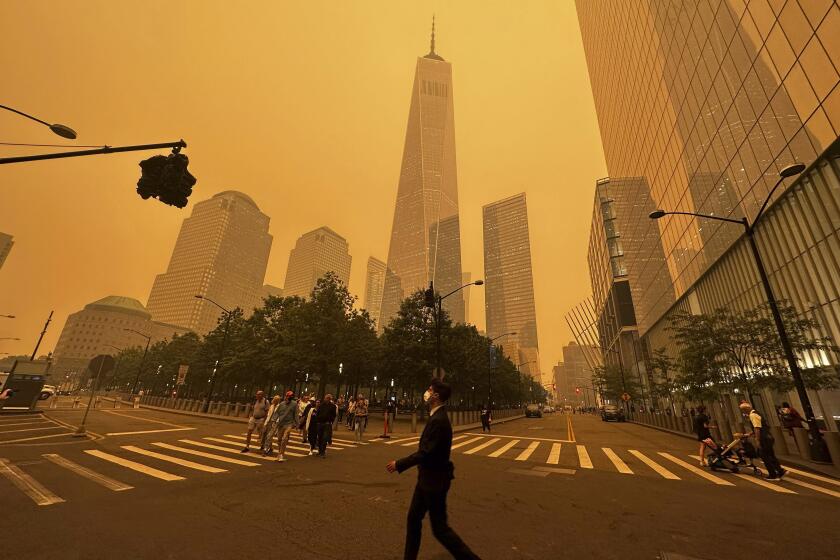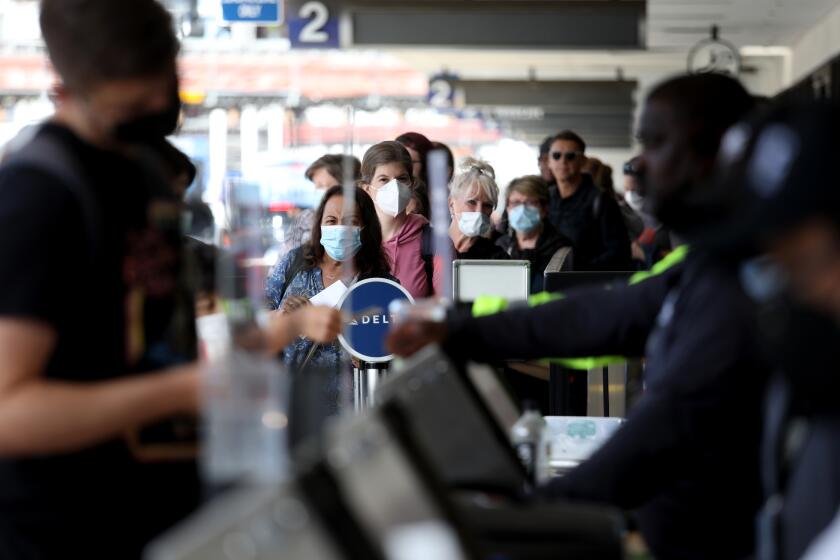Air quality disasters aren’t going away. Here’s how we should protect ourselves

- Share via
As California residents, we are all too familiar with the orange skies that plagued the East Coast last week from Canadian wildfires and just hit the Midwest. And we have faced the plague of poor outdoor air quality many times while doing extensive public health work in cities, such as India’s capital New Delhi, that are among the most polluted in the world. The pandemic drew global attention to the impact of air quality on health, with a focus on pathogens that spread indoors.
But hazy skies remind us that the outdoors pose an equal, if not worse, threat. Climate change increases catastrophic wildfires and other events, and outdoor air eventually penetrates the indoors. Air pollution affects everyone — yet protections from it remain inadequate nationwide.
Last month, the Centers for Disease Control and Prevention finally released long-awaited guidance on improving indoor air quality to limit the spread of infectious airborne pathogens. As a baseline for clean air, they recommended a minimum of five air changes per hour (ACH, referencing a flow equal to cycling through all air in an enclosed space) and upgrading air filters to a minimum efficiency reporting value (MERV) of 13 (a typical home, school or office has a MERV of 10 or less).
A smoky haze from fires in Canada has cast a pallor over the Northeast U.S. that’s all too familiar to those on the West Coast. Get used to these images as the horror of a changed climate come to life.
This is the first time we have an official target from the CDC, one also recognized by California’s Department of Public Health. Installing or upgrading central air systems to get five ACH — a level that is still too low for schools and other places — would be expensive in many buildings, as would the maintenance and energy costs. But five ACH or higher can be reached cost-effectively with in-room, portable air cleaners such as HEPA purifiers.
Outdoor air quality is a more complicated problem the U.S. has chased for decades. The need to reduce, monitor and regulate air pollution was a fundamental driver for the Nixon administration to create the Environmental Protection Agency. Today, the EPA has a list of “criteria air pollutants” — including carbon monoxide, lead, nitrogen oxides, ground-level ozone, particulate matter and sulfur oxides — that must be maintained within permissible levels. The EPA is also authorized under the 1970 Clean Air Act to regulate the emissions of hazardous pollutants. But actual implementation falls primarily to states and federal territories. As we saw with states’ pandemic responses, this inherently produces fragmented strategies with weak oversight and varying quality of safeguards.
In California, both the California Air Resources Board and the state public health department are tasked with managing outdoor air quality. During catastrophic events such as massive wildfires, the Department of Forestry and Fire Protection is also involved. That leaves multiple agencies with sometimes conflicting goals and approaches to monitor and regulate outdoor air, and our homes, schools and businesses are often ill-prepared for air quality emergencies despite their frequency.
The fragmented approach also forces individuals to rely on stop-gap measures during crises. Last week’s major public health messaging on the East Coast was for folks to stay indoors. Those with that option can purchase portable air filters for as little as $250 with less than $10 in monthly energy bills, or use do-it-yourself options popularized during the pandemic that are constructed from box fans, filters and other hardware store materials. (During New York City’s recent haze, HEPA purifiers went out of stock, making DIY cleaners particularly useful.) Indoor air quality meters, including those that measure common pollutants and gases such as fine particulate matter and carbon dioxide, will be crucial as severe weather events become more frequent.
By now we’ve learned playing catch-up on COVID is too little too late.
Of course, not everyone can stay inside. Those stuck outdoors during high-risk periods need high-filtration masks such as N95 respirators to reduce their inhalation of toxic airborne matter.
These inequities between those who can hole up at home and those who must mask up through the haze expose the limitations of individual-level solutions. Cost and availability will put protective materials out of reach for many; certain communities perform more outdoor labor and thus have more unavoidable outdoor exposure. An analysis from Gothamist found that asthma-related emergency room visits in New York last week were highest in low-income, predominantly Black and Latino neighborhoods.
The long-term solution to these health threats and inequities is, of course, to curtail outdoor air pollution by further reducing emissions from vehicles and factories and pursuing other climate change mitigation measures. But even if we do that, events that compromise outdoor air quality will persist and likely become more common because of how much climate change we’ve already allowed to happen.
That means we need better state and federal approaches. Buildings designed for healthier air flow will help save lives. Air quality levels are reported by federal and crowdsourced websites for most areas in the U.S., but this information should be further publicized and interpreted just like the weather so people can plan ahead and take steps to reduce their risk. The government should distribute N95 masks ahead of wildfire events (not afterward, as New York did last week), prioritize them for the most vulnerable and mandate them for all workplaces where employees have to spend significant time outdoors even during periods of poor air quality. Air filters and, where necessary, DIY solutions should be subsidized (or made free, as some organizations have done) for those who cannot afford them, and public health guidance should be provided on how to build, size and operate them in different spaces.
Leadership from the federal government, supported by state efforts, can handle this new reality. We must not fall victim to the same uncoordinated, fragmented and politicized forces that impeded our national pandemic response over the last few years.
Abraar Karan is an infectious disease doctor and researcher at Stanford University. Devabhaktuni Srikrishna is an electrical engineer and the founder of www.patientknowhow.com. Ranu Dhillon is an instructor at Harvard Medical School and a doctor at Brigham and Women’s Hospital.
More to Read
A cure for the common opinion
Get thought-provoking perspectives with our weekly newsletter.
You may occasionally receive promotional content from the Los Angeles Times.










